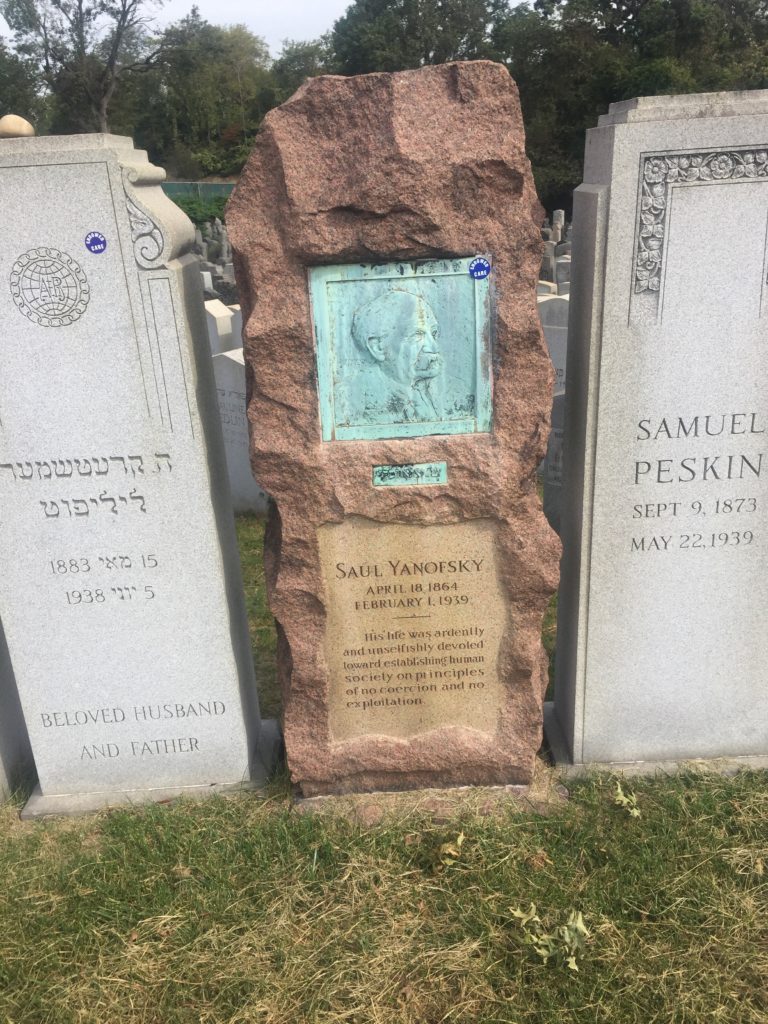Erik Visits an American Grave, Part 708
This is the grave of Saul Yanofsky.

Born in Russia in 1864, Yanofsky (sometimes spelled Yanovsky) is primarily known today for being the editor of Yiddish-language anarchist newspapers in New York. His father was a cantor and his grandfather a rabbi. He attended school in Bialystok, which was the center of the Jewish labor movement. He was part of the small number of Russian Jews who were able to achieve higher education in Russia in the relatively tolerant years before the assassination of Alexander II in 1881. Finding his opportunities far more limited with the growth of anti-Semitism after that event, he emigrated to the United States in 1885.
Yanofsky converted to anarchism in the aftermath of the Haymarket Trial. While engaging in the intellectual world of anarchist thought, he was also working hard at the kind of jobs that immigrants did and do: dishwashing, apparel sweatshops, sheet-metal worker. He was fired from some of these jobs for organizing his fellow workers. In 1890, he moved to England to edit an anarchist newspaper there and lived in London for five years before returning to the U.S. in 1895. He was forced to resign as editor after criticizing the anarchist bombing of a Barcelona theater in 1893 that killed over 30 people. Such actions were controversial within the anarchist community and frequently divided the movement.
He’s most known for being the editor of Fraye Arbeter Shtime beginning in 1899. This newspaper, which began in 1890 and lasted until 1977, was a major player in the Jewish intellectual left during the two decades that Yanofsky edited it. It was a combination of a labor newspaper and a radical intellectual magazine that also hosted well-known social events in the Jewish community. It would translate anarchists and communists into Yiddish for the masses, especially the works of Prince Kropotkin who was particularly popular in the Jewish anarchist community. It would also translate literary fiction from writers such as Ibsen and Wilde.
Yanofsky himself had a very popular and witty column that for many was the highlight of the paper. In fact, while he may not have edited it until 1898, he was involved in its creation and actually suggested the name, which translates to English as Free Voice of Labor. What’s more, Yanofsky revitalized not only the paper, but also the New York Jewish anarchist community, which was in decline in the late 1890s, divided and demoralized, He and his editorials provided a point of unity for the communities and while such a radical paper never had the readership of the Forward, it still was a very successful journal.
Unlike people such as Emma Goldman and Alexander Berkman who excused violence, Yanofsky was generally considered a pacifist in his anarchism. As with most anarchists who came of age in the 1880s, there is some evidence he was influenced by Johann Most’s “propaganda of the deed,” which justified the death of innocents if the action led to greater revolutionary activity, but he certainly never acted on it and may not have even really believed in it. He turned the paper away from its focus on people like Most and toward a greater focus on things such as workers cooperatives and other alternative forms of work and mutual cooperative enterprises. The paper’s office were trashed by a group of anti-anarchist Jewish kids after Leon Czolgosz assassinated William McKinley in 1901, a moment that greatly frightened Yanofsky and an act which he denounced.
In World War I, Yanofsky led Fraye Arbeter Shtime to be the only major anarchist publication in the U.S. to support the war effort, which followed Kropotkin’s endorsement of the war. He stepped down as editor in 1919, as he had spoken out against Lenin. The success of the Soviet Union would be a major blow to the international anarchist movement, as revolutionaries largely moved their ideology to what had actually won power. Holdouts such as Yanofsky and Goldman and Berkman were increasingly marginalized within radical communities in the 1920s and 1930s.
Yanofsky also edited other publications, mostly Yiddish. But he also was the first editor of the paper of the International Ladies’ Garment Workers Union, Justice, which he went to after leaving Fraye Arbeter Shtime. He really would have preferred the Industrial Workers of the World organized these workers and disliked the version of socialism of the ILG leaders but his first loyalty was to Jewish immigrant workers and so he worked with who had a chance to improve his people’s lives. He edited the ILG paper until 1925. He continued to write for leftist publications into the 1930s. Yanofsky died in 1939 in New York.
Saul Yanofsky is buried in Mount Carmel Cemetery, Queens, New York.
If you would like this series to visit other leftists, you can donate to cover the required expenses here. Morris Hillquit is also in Queens and Victor Berger is in Milwaukee. Previous posts in this series are archived here.
